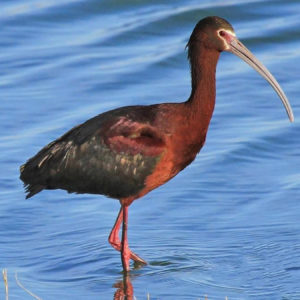Glossy Ibis

Scientific Name: Plegadis Falcinellus
IUCN (Red List) Status: Least Concern (LC)
The glossy ibis is about 20 inches tall with a wingspan of about three feet. It has a long, dark gray bill that is curved down. It has dark purple to black feathers on its head, neck, back and belly. Its legs are long and black and its wings and tail are a shiny green. The Glossy Ibis is a small dark ibis that looks black in the distance. At close quarters the neck is reddish-brown and the body is a bronze-brown with a metallic iridescent sheen on the wings. The distinctive long, curved bill is olive-brown, the facial skin is blue-grey with a bordering white line that extends around the eyes.
Habitat: Excellent swimmers, but prefer to stay on dry land, living primarily in hollow logs and abandoned mammal burrows. constrictors can live in the greatest variety of habitats ranging from sea level to moderate elevation, including deserts, wet tropical forests, open savannas and cultivated fields. They are both terrestrial and arboreal.
Animal Location: Savannah Sanctuary
Diet: The species feeds in very shallow water. The diet of the species varies seasonally depending on what is available. It takes adult and larval insects (e.g. aquatic beetles, dragonflies, grasshoppers, crickets, flies and caddisflies), worms, leeches, molluscs (e.g. snails and mussels), crustaceans (e.g. crabs and crayfish) and occasionally fish, frogs, tadpoles, lizards, small snakes and nestling birds.
Reproduction: It is highly gregarious, forming large roosts at least historically containing up to 10,000 individuals. while the nest is in a tree cavity 10-30 m above ground. Nesting is usually solitary, but can take place in loose colonies.


